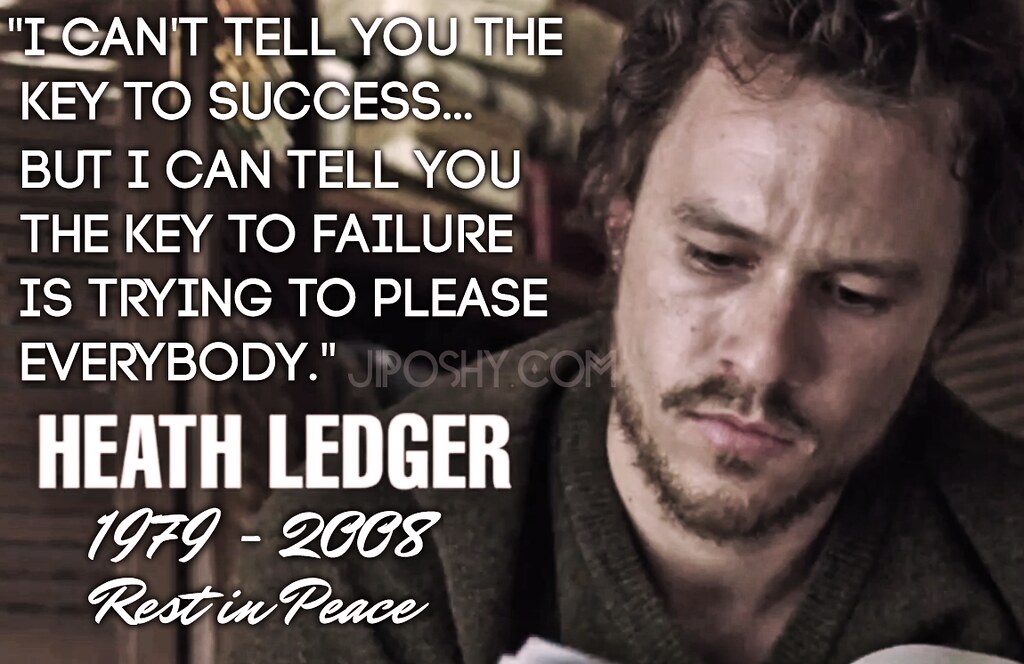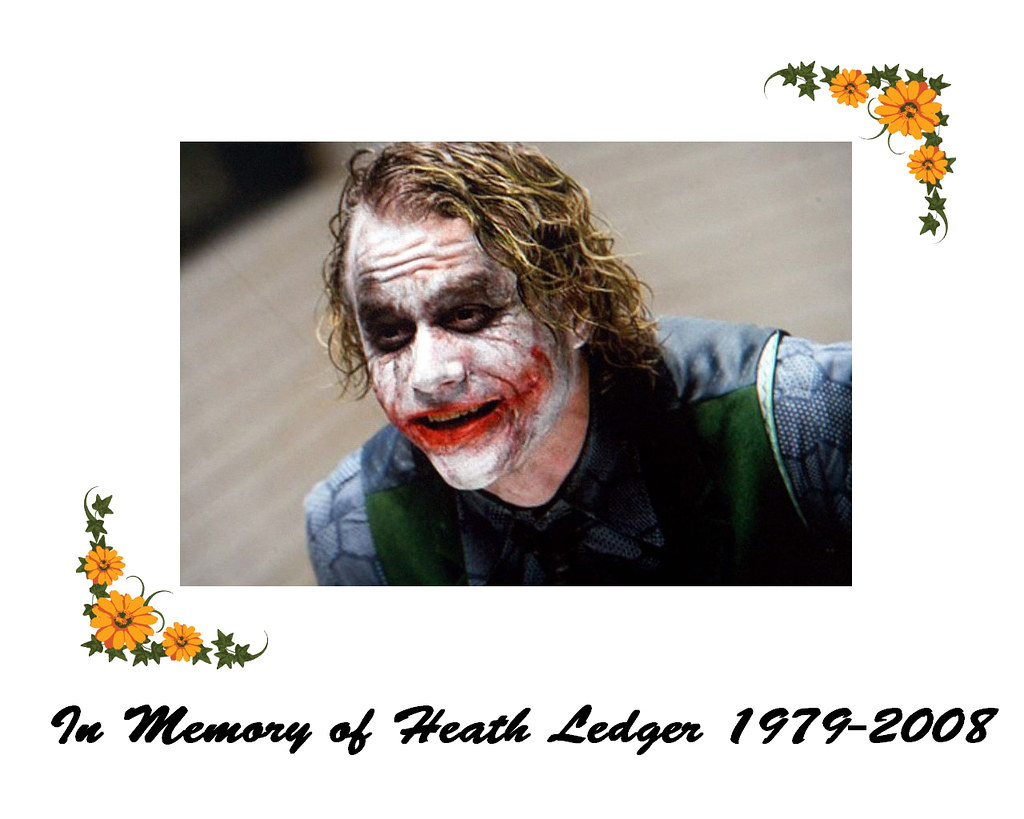
The sudden passing of Heath Ledger on January 22, 2008, sent shockwaves through Hollywood and around the globe. At just 28 years old, the handsome and profoundly talented Australian actor was at the zenith of his career, a cultural force whose performances had already etched an indelible mark on cinematic history. Yet, beneath the dazzling facade of success and critical acclaim lay a far more intricate and somber narrative, a “darker story” of intense dedication, relentless pressure, and deeply personal struggles that continue to captivate and haunt his admirers more than a decade later.
Fans remain perennially fascinated, not merely by the breathtaking scope of his work, but by the profound challenges and internal conflicts he wrestled with in the period leading up to his sudden demise. While the world celebrated his brilliance, Ledger himself was grappling with the heavy burdens that often accompany global stardom: the relentless demands of his craft, the intrusive glare of the spotlight, and a private torment that would ultimately contribute to his tragic final moments. His story, in its raw complexity, compels us to look beyond the headlines and explore the human cost of extraordinary talent.
This in-depth examination endeavors to unravel the multifaceted truths behind Heath Ledger’s final days, drawing exclusively from the factual accounts available. It is a chronicle of a bright star whose intensity burned so fiercely that it consumed him, a narrative woven with threads of artistic ambition, personal vulnerability, and the intricate, often unseen, struggles that define even the most celebrated lives. As we delve into the precipitating factors that shaped his last moments, we aim to understand the profound human story beneath the legend.

1. **Heath Ledger’s Early Years and Meteoric Rise to Stardom**Heath Andrew Ledger, born on April 4, 1979, in Perth, Australia, seemed destined for the stage from a remarkably young age. His innate talent became apparent early, with his first lead role as Peter Pan at a local theater company at the tender age of 10. This auspicious beginning set him on an undeniable trajectory toward the world of performance, where his natural charisma and burgeoning skill quickly gained recognition within his home country.
His transition to Hollywood was swift and decisive. By age 19, having already secured small roles in Australian films and television shows, Ledger made the ambitious leap to Los Angeles. It was his starring turn in the 1999 film *10 Things I Hate About You* that truly launched him into the international spotlight, taking Hollywood by storm and establishing him as a burgeoning leading man with undeniable appeal and depth. This early success was merely a prelude to a career that would rapidly ascend.
From there, Ledger’s star power only amplified with a series of diverse and impactful roles in films such as *The Patriot*, *Monster’s Ball*, and *A Knight’s Tale*. His ability to inhabit vastly different characters with authenticity and intensity marked him as an actor of rare caliber. By 2005, his brilliance culminated in a performance that would redefine his standing in the industry and stun both audiences and critics alike: his portrayal of Ennis Del Mar in the groundbreaking film *Brokeback Mountain*.
*The New York Times* lauded his work, remarking, “Mr. Ledger magically and mysteriously disappears beneath the skin of his lean, sinewy character.” The review continued with effusive praise, declaring it “a great screen performance, as good as the best of Marlon Brando and Sean Penn.” This transformative role earned Ledger an Academy Award nomination for Best Actor, making him, at 26, one of the youngest actors ever to receive such an honor, solidifying his reputation as a serious and formidable artist.

2. **The Pressure of Perfection and Unwavering Dedication to Roles**Heath Ledger’s unparalleled dedication to his craft was a defining characteristic, one that was frequently cited by his peers and directors alike. He was renowned for his immersive approach to acting, a commitment that saw him “pour everything into his roles,” a testament to his profound respect for the characters he portrayed and the narratives he helped to shape. This all-consuming intensity, while yielding extraordinary results on screen, exacted a significant personal toll.
Those close to him often observed that Ledger “often pushed himself to extremes,” a drive fueled by a relentless pursuit of authenticity and emotional truth. He was known to literally “live inside his characters, always thinking about his work,” a method that blurred the lines between his professional and personal existence. This profound level of commitment, though integral to his artistic triumphs, was not without its shadows, leaving him frequently depleted.
Friends and colleagues revealed that this very intensity left him “drained,” an exhaustion that penetrated beyond the physical. While his artistry captivated millions and garnered widespread acclaim, the demands of such deep immersion meant that his “personal energy suffered” significantly. This was not a mere inconvenience but a profound depletion that chipped away at his well-being, a stark contrast to the vibrant, energetic image he projected to the world.
Indeed, Ledger himself alluded to the immense internal pressure he faced, even expressing dissatisfaction with his own perceived performance. Describing his role in *I’m Not There*, a film inspired by Bob Dylan, he admitted, “I stressed out a little too much,” and candidly stated that he wasn’t “proud” of his portrayal. This revealing confession underscores the extraordinarily high standards he held for himself, standards that contributed to both his genius and his personal struggles.
Read more about: Jennifer Aniston’s Age-Defying Secrets: An In-Depth Look at Her Philosophy, Procedures, and Path to Timeless Radiance

3. **The Psychological Toll of the Joker Role**Heath Ledger’s portrayal of the Joker in *The Dark Knight* is almost universally regarded as a masterclass in cinematic villainy, widely considered to be “one of the greatest depictions of the character, if not the greatest.” However, the intensity required to embody such a complex and malevolent figure came with significant psychological costs, profoundly impacting Ledger in the months leading up to his death. His immersion in the character was, by any measure, extraordinary and deeply taxing.
Ledger meticulously crafted his version of the Joker, a process that demanded profound isolation and intense psychological excavation. He explained, “I sat around in a hotel room in London for about a month, locked myself away, formed a little diary, and experimented with voices.” This deliberate self-confinement and method acting approach were instrumental in forging the chillingly chaotic and nihilistic character that would later earn him a posthumous Academy Award.
His own description of the Joker as “a psychopathic, mass-murdering, schizophrenic clown with zero empathy” reveals the disturbing nature of the persona he had to inhabit. Director Christopher Nolan and actor Christian Bale frequently commented on Ledger’s unwavering commitment. Bale told *The Hollywood Reporter*, “We’re treating this as serious drama… You go into character and you stay in the character. I love that. I find that so ridiculous that I love it, and I take that very seriously. Heath was definitely embracing that.”
Ledger’s interpretation consciously eschewed the more campy or jester-like elements of previous Jokers. Nolan elaborated on the influences, noting, “Johnny Rotten, Sid Vicious, these kinds of punk influences were some of the things we talked about.” He also cited “the character of Alex in *A Clockwork Orange*. He’s very anarchic and yet somehow has great charisma.” This deep dive into such dark, anarchic archetypes, while leading to an iconic performance, undoubtedly “took such a toll on him,” intensifying his existing personal vulnerabilities.
Read more about: Beyond the Screen: The Most Infamous Cinematic Moments That Ignited Chaos in Theaters and Triggered Real-World Turmoil

4. **The Struggle with Insomnia and Debilitating Exhaustion**Central to the tragic narrative of Heath Ledger’s final days was his profound and debilitating struggle with insomnia. The actor openly admitted that “insomnia haunted him,” a relentless mental torment that prevented his mind from resting even when his body was utterly exhausted. Nights frequently passed “without relief,” trapping him in a harrowing cycle of sleeplessness and mounting fatigue.
This relentless battle against sleep deprivation became a significant factor in his deteriorating health. Ledger explicitly detailed the severity of his condition, stating, “Last week I probably slept an average of two hours a night.” He described a mind that would simply not cease its activity: “I couldn’t stop thinking. My body was exhausted, and my mind was still going.” This constant mental activity, coupled with physical weariness, created a dangerous and unsustainable equilibrium.
In his desperate attempts to find respite, Ledger sought relief through medication, acknowledging that “he tried to fight it with medication, but that brought risks of its own.” He recounted a particularly harrowing night where, desperate for sleep, he took an Ambien. When the initial dose proved ineffective, he took another, only to wake an hour later with his mind still racing, highlighting the futility and frustration of his efforts to achieve natural rest.
His friend and dialect coach, Gerry Grennell, who lived with Ledger during the actor’s final weeks, bore witness to the severity of his insomnia firsthand. Grennell recalled, “I would hear him wandering around the apartment and I’d get up and say, ‘Come on, man, get back to bed, you have to work tomorrow,’” only for Ledger to reply, “‘I can’t sleep, man.’” These profound issues, far from subsiding, persisted even after the intense filming of *The Dark Knight* had concluded, indicating a chronic condition rather than a temporary consequence of his work.
Read more about: Shocking Truth: Why Your Daily Energy Drink May Be Making You More Tired Than Ever

5. **The Burden of Fame and His Deep Need for Privacy**While Heath Ledger undoubtedly found profound joy and fulfillment in the act of creation and performance, he harbored a distinct aversion to the pervasive trappings of celebrity. “He enjoyed acting, but he never enjoyed the constant spotlight,” a sentiment that frequently placed him at odds with the demands of his chosen profession. The relentless intrusion of paparazzi, the endless string of interviews, and the incessant public attention “weighed heavily on him,” proving to be a significant source of stress and discomfort.
Ledger possessed a deep-seated appreciation for solitude and personal space, valuing his private moments above the glittering, public-facing aspects of stardom. He cherished the quietude of his personal life, especially the time he spent with his daughter and his closest friends. This profound desire for an ordinary existence often clashed starkly with the extraordinary reality of being a global celebrity, creating an internal dissonance that was difficult to reconcile.
The tabloids of New York, in particular, frequently painted a superficial picture of Ledger during his final months. They often portrayed him as “a young, carefree actor who was enjoying parties and hooking up with models,” contributing to a public image that was far removed from his true state. However, as the detailed accounts reveal, the “truth was far darker,” depicting a man grappling with serious internal battles rather than indulging in an untroubled hedonism.
This conflict between his gentle and introspective nature and the aggressive demands of fame was a constant struggle. His innate sensitivity meant that the “gentle nature clashed with the pressure of fame,” leaving him exposed and vulnerable to an industry that often prioritized public image over personal well-being. This pervasive burden undoubtedly contributed to the complex tapestry of challenges he faced in his final days.
Read more about: From Red Carpet Kid to Reclusive Angler: The Jaw-Dropping Transformation of Tom Cruise and Nicole Kidman’s Son, Connor

6. **His Personal Life in Decline: The End of the Relationship with Michelle Williams**In the wake of his critical triumph in *Brokeback Mountain*, Heath Ledger found not only professional acclaim but also a deeply significant personal connection. It was on the set of this transformative film that he met actress Michelle Williams, initiating what was described as “a whirlwind relationship.” The couple soon established a home together in Brooklyn, New York, and in late 2005, they welcomed their daughter, Matilda Rose, into the world. At this juncture, with a string of successful performances and a committed partner and child, Ledger appeared to be “a budding superstar in the making,” enjoying a period of immense personal and professional fulfillment.
However, this period of seeming stability and happiness proved tragically ephemeral. By September 2007, a profound shift had occurred: Ledger’s relationship with Williams had “come to an end.” This dissolution of his most cherished personal connection marked a significant turning point, sending him into a period of acute emotional distress. While Williams remained in their Brooklyn home, Ledger relocated to Manhattan, a move that coincided with his becoming a frequent subject of the relentless New York tabloids.
Those closest to Ledger observed the profound impact of this separation. Gerry Grennell, his dialect coach and friend, noted that Ledger was “having a tough time dealing with the end of his relationship with Williams.” The emotional void left by the separation was immense, as Ledger desperately missed his family unit. Grennell recalled, “He missed his girl, he missed his family, he missed his little girl — he desperately wanted to see her and hold her and play with her.”
The separation clearly contributed to a deepening sense of despair within the actor. The joy and stability he had found with Michelle and Matilda were gone, leaving him in a state of profound unhappiness. Grennell’s observations painted a poignant picture of Ledger’s emotional state, underscoring the depth of his sorrow: “He was desperately unhappy, desperately sad.” This personal upheaval, coupled with his ongoing professional pressures and internal struggles, created a particularly vulnerable period in his life.
7. **The Path to Self-Medication and Reported Prescription Drug Dependency**The confluence of intense professional demands, debilitating insomnia, and profound personal heartbreak created a perilous pathway for Heath Ledger: the increasing reliance on self-medication. As outlined in various accounts, Ledger was “reportedly growing dependent on prescription drugs” in the final months of his life, a coping mechanism born out of a desperate need for relief from his overwhelming symptoms and emotional distress.
The persistent and severe insomnia, which Ledger openly discussed, played a critical role in this trajectory. His inability to achieve natural, restorative sleep led him to “attempted to self-medicate just to get some rest.” This was not merely a casual use of medication, but a focused effort to alleviate an unbearable physiological and psychological burden, even if it meant navigating the inherent risks of such a strategy.
Concerns about his reliance on various medications were not confined to Ledger himself; his family was acutely aware of the dangers. In a particularly poignant and tragic detail, Ledger’s father later revealed a final, fateful conversation. “His sister was on the phone to him the night before telling him not to take the prescription medications with the sleeping tablets.” This direct warning underscores the known risks and the family’s apprehension regarding his medication regimen.
Tragically, Ledger’s response to his sister, “Katie, Katie, I’m fine. I know what I’m doing,’” reflected a deeply ingrained belief in his own control, even in the face of escalating concerns. This statement, delivered just hours before his death, serves as a heartbreaking testament to his attempt to manage an unmanageable situation. His path to self-medication, intended to alleviate suffering, instead inadvertently set the stage for the accidental overdose that would claim his life.” , “_words_section1”: “1945
8. **The Tragic Discovery in His Manhattan Apartment**The narrative of Heath Ledger’s final moments culminates in the grim discovery made on January 22, 2008, within the confines of his Manhattan loft. On that fateful day, his housekeeper, who had heard him snoring earlier around 12:30 p.m., initially believed he was simply sleeping late, a testament to the normalcy that can sometimes precede tragedy. However, this illusion of routine would soon shatter, revealing a far more devastating reality beneath the surface.
At approximately 2:45 p.m., Ledger’s masseuse arrived for a scheduled appointment. Receiving no response to her repeated knocks on his bedroom door, a growing sense of unease prompted further action. Together, the masseuse and housekeeper cautiously pushed open the door, only to be confronted with a harrowing sight: Ledger lay unconscious and on the floor. In a desperate attempt to revive him, both women tried to rouse him, but their efforts proved futile, compelling them to call for immediate help.
Adding another layer of poignancy to this scene, a copy of a script he had been diligently working on for director Stephen Gaghan, an adaptation of Malcolm Gladwell’s *Blink: The Power of Thinking Without Thinking*, lay nearby. Scrawled upon it was Gaghan’s phone number, a detail that would lead to an agonizing phone call for the director. Gaghan recounted the devastating call he received from Ledger’s father, who had spotted the number, conveying the news of his son’s passing and the profound shock gripping those closest to him. It was a moment that underscored the sudden and brutal finality of Ledger’s brilliant, yet tragically short, life.
Read more about: The Enduring Legacy of Robert Redford: Unraveling the Lives and Tragedies That Shaped His Children’s Journeys
9. **Official Findings: An Accidental Overdose of Prescription Medications**The initial shock and widespread speculation surrounding Heath Ledger’s sudden death necessitated a thorough official investigation to ascertain the precise cause. The New York City medical examiner’s office soon provided clarity, attributing his demise to an accidental overdose of prescription medications. This finding definitively addressed many of the swirling rumors, asserting that his death was not a suicide but rather an unintentional consequence of a complex medication regimen.
The specific cocktail of substances that proved fatal was later identified as “acute intoxication by the combined effects of oxycodone, hydrocodone, diazepam, temazepam, alprazolam, and doxylamine.” This extensive list comprised a dangerous mix of painkillers, anti-anxiety drugs, and sleeping pills, each contributing to a cumulative effect that his body could not withstand. Experts elucidated that such a combination could cause a person’s brain and brain stem to effectively “fall asleep,” leading to a cessation of vital heart and lung function.
Throughout the investigation, authorities reiterated that all reports indicated Ledger’s death was accidental. The medical examiner’s office concluded, “We have concluded that the manner of death is accident[al], resulting from the abuse of prescribed medications.” This formal statement underscored the tragic irony of his attempts to manage his relentless insomnia and anxiety through medication, inadvertently leading him to an unforeseen and fatal precipice.

10. **The Controversial Aftermath: Mary-Kate Olsen’s Involvement**Despite the official ruling of accidental overdose, the circumstances surrounding Heath Ledger’s death continued to generate questions and public scrutiny. A particularly notable aspect of the subsequent investigation revolved around actress Mary-Kate Olsen, a close friend of Ledger’s at the time. It was revealed that Ledger’s masseuse had made a series of phone calls to Olsen shortly after discovering his unconscious body, a detail that immediately fueled public speculation.
Questions arose concerning Olsen’s potential knowledge of, or even involvement in, Ledger’s access to the prescription drugs that ultimately claimed his life. The situation escalated when Olsen refused to cooperate with the Drug Enforcement Administration (DEA) during their investigation, unless she was granted immunity from any future prosecution. This decision, though legally within her rights, only deepened suspicions in the eyes of many observers, suggesting a potential desire to avoid incriminating herself or others.
Further adding to the controversial narrative, it was reported that Olsen had dispatched private security personnel to Ledger’s apartment after receiving the call, rather than immediately contacting emergency services or the police. While her lawyer, Michael C. Miller, explicitly stated, “Despite tabloid speculation, Mary-Kate Olsen had nothing whatsoever to do with the drugs found in Heath Ledger’s home or his body, and she does not know where he obtained them,” the public remained largely unconvinced, reflecting the intense media scrutiny and the perplexing nature of the events.
11. **Lingering Enigmas: The Unidentified Source of Painkillers**The intricate investigation into Heath Ledger’s accidental overdose, while clarifying the official cause of death, ultimately left some critical questions unanswered, particularly regarding the precise origin of all the medications found in his system. Prosecutors from the U.S. Attorney’s Office, after a thorough review, eventually declared that they “don’t believe there’s a viable target” in identifying who might have provided Ledger with the painkillers.
It was confirmed that Ledger had legally obtained the anti-anxiety medications and sleeping pills from doctors in California and Texas, indicating legitimate prescriptions for his struggles with insomnia and stress. However, the source of the powerful painkillers, specifically oxycodone and hydrocodone, which were a significant component of the fatal combination, remained elusive. This ambiguity contributed to the ongoing speculation and sense of incompleteness surrounding the tragic event.
To this day, the exact means by which Ledger acquired the painkillers that contributed to his untimely death remains shrouded in a degree of mystery. This unresolved element adds a poignant layer to the narrative, highlighting the complex and often clandestine pathways through which prescription medications can be obtained. Despite the official closure of the investigation, this specific detail continues to be a subject of quiet contemplation for those who remember the young actor’s tragic end.
12. **A Father’s Heartbreak and the Burden of Blame**The profound impact of Heath Ledger’s death resonated most deeply with his family, who grappled not only with immense grief but also with the agonizing question of responsibility. Years after the tragedy, his father, Kim Ledger, offered a heartbreakingly candid perspective, placing the ultimate accountability squarely on his son. It was a statement born not of anger, but of a profound, anguished love.
“It was totally his fault,” Kim Ledger stated, reflecting on the accidental overdose. He elaborated with a painful clarity, asserting, “It was no one else’s — he reached for them. He put them in his system. You can’t blame anyone else in that situation. That’s hard to accept because I loved him so much and was so proud of him.” This raw admission underscored the unbearable pain of watching a loved one make choices that ultimately lead to such a devastating outcome, a parent’s ultimate helplessness.
Heath Ledger’s death at the exceptionally young age of 28 not only prematurely severed a promising acting career that was still ascending but also utterly devastated his family. Their loss was immeasurable, marked by the abrupt departure of a son, brother, and father whose brilliance had illuminated their lives. Kim Ledger’s words serve as a poignant reminder of the personal accountability that can accompany self-medication and the enduring sorrow left in its wake.
Read more about: 12 Film Deaths That Stayed With Us: Devastating Scenes From Cinema’s Most Unforgettable Fare

13. **Michelle Williams and Matilda: An Enduring Legacy of Love**The news of Heath Ledger’s passing was met with profound grief, nowhere more acutely felt than by his former partner, actress Michelle Williams, and their young daughter, Matilda Rose. Despite their relationship having ended months prior, Williams was utterly distraught, expressing the depth of her sorrow in a public statement that conveyed both personal anguish and enduring love. Her heart, she declared, was unequivocally broken by the devastating loss of Matilda’s father.
In the weeks that followed Ledger’s death, Williams articulated the poignant way she and his family would keep his memory alive for their daughter. “His family and I watch Matilda as she whispers to trees, hugs animals, and takes steps two at a time, and we know that he is still with us,” she shared. This tender imagery painted a picture of a little girl embodying her father’s spirit, a spiritual connection transcending the physical absence, ensuring he remained a vibrant, living presence in their lives.
Michelle Williams vowed that Matilda “will be brought up in the best memories of him,” a commitment to preserving the warmth and love that defined Heath Ledger’s paternal bond. Today, Matilda Rose is 19, a testament to the passage of time, yet the unwavering dedication of her mother and Ledger’s family has ensured that his legacy as a loving father endures, shaped by cherished recollections and an unbroken chain of affection. His premature departure undoubtedly cast a long shadow, but the love for his daughter, and the way her spirit mirrors his, offers a continuous, vibrant connection.
14. **The Undiminished Legacy: An Iconic Actor Remembered**While the tragic circumstances of Heath Ledger’s final days are undeniably a somber part of his story, they do not define the entirety of his impact. His professional legacy, rich with incandescent performances and fearless artistic choices, continues to resonate powerfully within the world of cinema. From his breakout role in *10 Things I Hate About You* to his transformative portrayal in *Brokeback Mountain*, and ultimately to his iconic, posthumously honored performance as the Joker in *The Dark Knight*, his work remains a profound source of inspiration.
Heath Ledger’s intensity, his profound dedication, and his ability to completely inhabit diverse characters continue to be studied by young actors and celebrated by seasoned directors. His films are revisited regularly by fans who remember his passion, his unique charisma, and the indelible marks he left on screen. The depth of his artistry ensured that his influence would not be diminished by his untimely departure; instead, it grew, cementing his place among the greats of his generation.
It is crucial to note that several common misconceptions surrounding his death have been clarified over time. Ledger had completed filming for *The Dark Knight* prior to his passing, though the film was released six months later. His final completed film role was *The Imaginarium of Doctor Parnassus*, which required other actors to complete his scenes, a testament to the industry’s desire to honor his unfinished work. Furthermore, official reports categorically state his death was an accidental overdose, not suicide, and there was no evidence of long-term drug addiction, but rather a struggle with acute insomnia and reliance on multiple medications. These clarifications ensure that his powerful artistic legacy remains untainted by rumor, allowing his brilliance to shine eternally.
Read more about: Rick Davies, Supertramp Co-Founder and Voice Behind Iconic Hits, Dies at 81: A Legacy of Progressive Rock and Pop Innovation
Heath Ledger’s story, in its entirety, is a poignant testament to the profound complexities of human existence, especially when intertwined with the relentless demands of extraordinary talent and global fame. His journey reminds us that behind the dazzling brilliance of a superstar often lie unseen battles—struggles with the very pressures that fuel their artistry. Though his time among us was tragically brief, the echoes of his performances, the lessons learned from his vulnerabilities, and the enduring power of his influence continue to inspire, provoke thought, and remind us of the precious, fragile nature of life, and the indelible mark one person can leave on the world.









